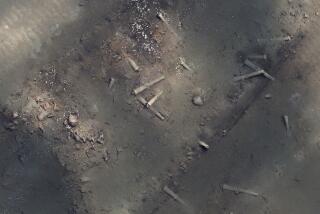Slave Ship Makes Final Painful Journey
- Share via
FORT WORTH, Texas — Walking through a corridor of the Henrietta Marie’s lower deck, Josie Gordon confronted a deep sadness as she viewed statues of slaves huddled in metal chains.
“I could hear their voices,” she said. “I could see the pain.”
Raised from the depths of history from the sea near the Florida Keys, the slave ship Henrietta Marie has embarked on one final voyage.
Archeologists have assembled parts of the ship and its interior for a national tour; it was on display at the Fort Worth Museum of Science and History until Jan. 4. Thousands visited.
“For the first time in my life I understand where the roots of racial disharmony in our country began,” Gordon said.
The London-based vessel was a slave ship that transported Africans and trade goods among three continents. The boat sank in 1700 on a return trip to England. No slaves were aboard.
While visitors walk through a re-creation of the ship’s lower deck, an audio recording describes the conditions in which slaves were brought to North America in the early 1700s--the feces piled upon the floor, the blood and mucus on the deck.
“This is something every black person should see,” Gordon said after a recent visit. “They have to see it.”
Historians say it was common for dozens of Africans to die on the ships that transported them. Almost all were separated from their families when they were sold.
But the horrifying conditions often began long before the ships left Africa. Those captured were kept in dungeon-like forts for weeks, while sailors rested and gathered supplies.
“There is definitely one section of our country that wants to forget that this ever happened . . . and that would be easy for them to do,” said Hosell Gordon, a visitor from Fort Worth. “However, had it been their forefathers, they would be less likely to forget. The oppressors always want to forget.”
The release of Steven Spielberg’s new movie “Amistad,” an epic about a slave ship revolt, also has drawn people to the Henrietta Marie.
“We have a lot of people coming in here asking how much of what they’ve heard about and seen in ‘Amistad’ is accurate,” said Melinda Mains, director of marketing at the museum. “The exhibit combined with the movie are really creating a dynamic consciousness about this part of our history.”
The Henrietta Marie’s reemergence began in 1983, when underwater archeologist David Moore began excavating the remains of an English ship off the Florida Keys. His team also recovered an iron bell--etched into the side were the words “Henrietta Marie 1699”--and eventually, the decaying remains of the slave ship were hauled up.
Many of the artifacts that were recovered--shackles, cannonballs, spoons and belt buckle--were almost perfectly preserved by the seabed muck.
Eleven-year-old Morgan Vanderbilt of Fort Worth frowned as she read about how slaves were abused on their journey to North America. She was most bothered by the tiny silver shackles used to lock up the slaves.
“It was wrong for them to treat them like that,” she said. “I hope we never let that happen to anyone again.”
More to Read
Sign up for The Wild
We’ll help you find the best places to hike, bike and run, as well as the perfect silent spots for meditation and yoga.
You may occasionally receive promotional content from the Los Angeles Times.






